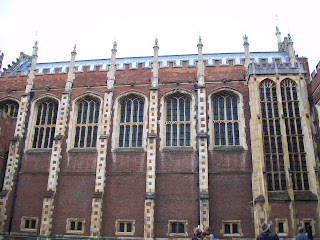 Henry VIII was a complex, powerful king. His firm belief in the superiority of the king over the Church lead to his break from Rome and the English Reformation.
His founding of the Church of England was to have massive effects upon the history of the World.
Henry VIII was a complex, powerful king. His firm belief in the superiority of the king over the Church lead to his break from Rome and the English Reformation.
His founding of the Church of England was to have massive effects upon the history of the World.
 After forming the Church of England (with the King as its leader), Henry was quick to realize the vast fortunes held by the numerous Catholic Abby's and Monasteries were his for the taking.
The forced secularization, confiscation and ultimate destruction of these brought millions into the coffers of Henry and his favorite courtiers.
After forming the Church of England (with the King as its leader), Henry was quick to realize the vast fortunes held by the numerous Catholic Abby's and Monasteries were his for the taking.
The forced secularization, confiscation and ultimate destruction of these brought millions into the coffers of Henry and his favorite courtiers.
 Henry loved to flaunt his wealth and power. How many gems and pearls can you count in this painting of the king?
Henry loved to flaunt his wealth and power. How many gems and pearls can you count in this painting of the king?
 In his younger days Henry was very athletic and enjoyed jousting. This is one of his suits of armor for the latter.
In his younger days Henry was very athletic and enjoyed jousting. This is one of his suits of armor for the latter.
 Henry was frantic to have a legitimate male heir. Here he his is seen with Edward the Prince of Wales and Edward's mother Jane Seymour. The interesting feature of this painting is that Jane died in childbirth with Edward-Henry really appreciated her sacrifice.
Henry was frantic to have a legitimate male heir. Here he his is seen with Edward the Prince of Wales and Edward's mother Jane Seymour. The interesting feature of this painting is that Jane died in childbirth with Edward-Henry really appreciated her sacrifice.
 The Tudor Rose became a popular emblem and is still in use by the British Royalty.
The Tudor Rose became a popular emblem and is still in use by the British Royalty.
 Henry's need for and heir, greed and unfortunate choice in some women lead to his having six wives. Catherine of Aragon was his older brother Arthur's wife. Henry married her after Arthur (15 years old) died in 1502. Before their divorce, Henry and Catherine were married for 24 years with one surviving child-Mary. Next came the tragic Anne Boleyn, her three-year reign produced Elizabeth and cost Anne her head. Jane Seymour lasted a year and a half dying in childbirth giving Henry his only legitimate male heir-Edward. Anne of Cleves lasted half a year before the divorce. Catherine Howard lasted two years before her infidelity cost her and her lovers their heads. Catherine Parr (perhaps the luckiest of the lot) outlived the powerful king. In 1547, the once handsome and powerful man died an obese (his waist was over 54 inches) man, with gout, multiple pus-filled sores and with toes rotting from gangrene.
Henry's need for and heir, greed and unfortunate choice in some women lead to his having six wives. Catherine of Aragon was his older brother Arthur's wife. Henry married her after Arthur (15 years old) died in 1502. Before their divorce, Henry and Catherine were married for 24 years with one surviving child-Mary. Next came the tragic Anne Boleyn, her three-year reign produced Elizabeth and cost Anne her head. Jane Seymour lasted a year and a half dying in childbirth giving Henry his only legitimate male heir-Edward. Anne of Cleves lasted half a year before the divorce. Catherine Howard lasted two years before her infidelity cost her and her lovers their heads. Catherine Parr (perhaps the luckiest of the lot) outlived the powerful king. In 1547, the once handsome and powerful man died an obese (his waist was over 54 inches) man, with gout, multiple pus-filled sores and with toes rotting from gangrene.
 Of his three heirs, two died after short reigns but Elizabeth I was to become one of the greatest monarchs in English History.
Of his three heirs, two died after short reigns but Elizabeth I was to become one of the greatest monarchs in English History.
















